Dissertation Prospectus on Cloud Computing Adoption Factors
VerifiedAdded on 2022/08/24
|44
|12928
|11
Project
AI Summary
This dissertation prospectus explores the factors influencing cloud computing adoption among IT leaders in Virginia, Washington, D.C., and Maryland. The introduction highlights the growing importance of cloud computing and identifies a research gap related to understanding the factors that affect its adoption in the specified geographic area. The background of the problem discusses the evolution of cloud computing and the reluctance of organizations to adopt it, citing issues like security and data protection. The theoretical foundations section proposes the use of the Technology-Organization-Environment (TOE) framework and the Diffusion of Innovations (DOI) theory to provide a comprehensive understanding of the adoption barriers. The literature review explores the history and definition of cloud computing, cloud adoption theories, and clusters of influencing factors. The prospectus includes a detailed examination of the existing literature, problem statement, purpose of the study, and research questions. The study will analyze factors influencing cloud adoption and how IT leaders describe them. The methodology and design sections need to be completed by January 18, and the entire document is due by January 22. The study uses a combined TOE+DOI adoption model.
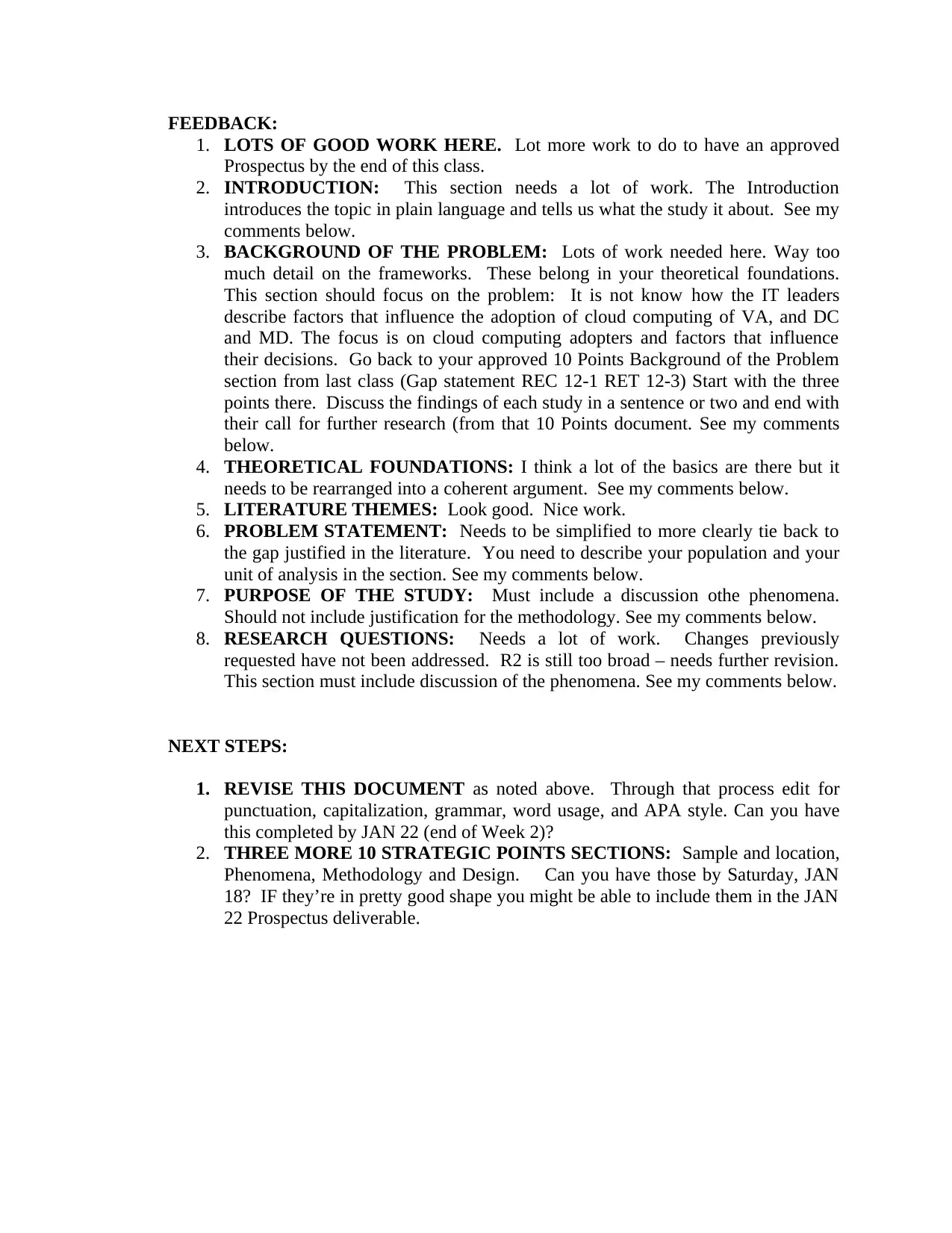
FEEDBACK:
1. LOTS OF GOOD WORK HERE. Lot more work to do to have an approved
Prospectus by the end of this class.
2. INTRODUCTION: This section needs a lot of work. The Introduction
introduces the topic in plain language and tells us what the study it about. See my
comments below.
3. BACKGROUND OF THE PROBLEM: Lots of work needed here. Way too
much detail on the frameworks. These belong in your theoretical foundations.
This section should focus on the problem: It is not know how the IT leaders
describe factors that influence the adoption of cloud computing of VA, and DC
and MD. The focus is on cloud computing adopters and factors that influence
their decisions. Go back to your approved 10 Points Background of the Problem
section from last class (Gap statement REC 12-1 RET 12-3) Start with the three
points there. Discuss the findings of each study in a sentence or two and end with
their call for further research (from that 10 Points document. See my comments
below.
4. THEORETICAL FOUNDATIONS: I think a lot of the basics are there but it
needs to be rearranged into a coherent argument. See my comments below.
5. LITERATURE THEMES: Look good. Nice work.
6. PROBLEM STATEMENT: Needs to be simplified to more clearly tie back to
the gap justified in the literature. You need to describe your population and your
unit of analysis in the section. See my comments below.
7. PURPOSE OF THE STUDY: Must include a discussion othe phenomena.
Should not include justification for the methodology. See my comments below.
8. RESEARCH QUESTIONS: Needs a lot of work. Changes previously
requested have not been addressed. R2 is still too broad – needs further revision.
This section must include discussion of the phenomena. See my comments below.
NEXT STEPS:
1. REVISE THIS DOCUMENT as noted above. Through that process edit for
punctuation, capitalization, grammar, word usage, and APA style. Can you have
this completed by JAN 22 (end of Week 2)?
2. THREE MORE 10 STRATEGIC POINTS SECTIONS: Sample and location,
Phenomena, Methodology and Design. Can you have those by Saturday, JAN
18? IF they’re in pretty good shape you might be able to include them in the JAN
22 Prospectus deliverable.
1. LOTS OF GOOD WORK HERE. Lot more work to do to have an approved
Prospectus by the end of this class.
2. INTRODUCTION: This section needs a lot of work. The Introduction
introduces the topic in plain language and tells us what the study it about. See my
comments below.
3. BACKGROUND OF THE PROBLEM: Lots of work needed here. Way too
much detail on the frameworks. These belong in your theoretical foundations.
This section should focus on the problem: It is not know how the IT leaders
describe factors that influence the adoption of cloud computing of VA, and DC
and MD. The focus is on cloud computing adopters and factors that influence
their decisions. Go back to your approved 10 Points Background of the Problem
section from last class (Gap statement REC 12-1 RET 12-3) Start with the three
points there. Discuss the findings of each study in a sentence or two and end with
their call for further research (from that 10 Points document. See my comments
below.
4. THEORETICAL FOUNDATIONS: I think a lot of the basics are there but it
needs to be rearranged into a coherent argument. See my comments below.
5. LITERATURE THEMES: Look good. Nice work.
6. PROBLEM STATEMENT: Needs to be simplified to more clearly tie back to
the gap justified in the literature. You need to describe your population and your
unit of analysis in the section. See my comments below.
7. PURPOSE OF THE STUDY: Must include a discussion othe phenomena.
Should not include justification for the methodology. See my comments below.
8. RESEARCH QUESTIONS: Needs a lot of work. Changes previously
requested have not been addressed. R2 is still too broad – needs further revision.
This section must include discussion of the phenomena. See my comments below.
NEXT STEPS:
1. REVISE THIS DOCUMENT as noted above. Through that process edit for
punctuation, capitalization, grammar, word usage, and APA style. Can you have
this completed by JAN 22 (end of Week 2)?
2. THREE MORE 10 STRATEGIC POINTS SECTIONS: Sample and location,
Phenomena, Methodology and Design. Can you have those by Saturday, JAN
18? IF they’re in pretty good shape you might be able to include them in the JAN
22 Prospectus deliverable.
Paraphrase This Document
Need a fresh take? Get an instant paraphrase of this document with our AI Paraphraser
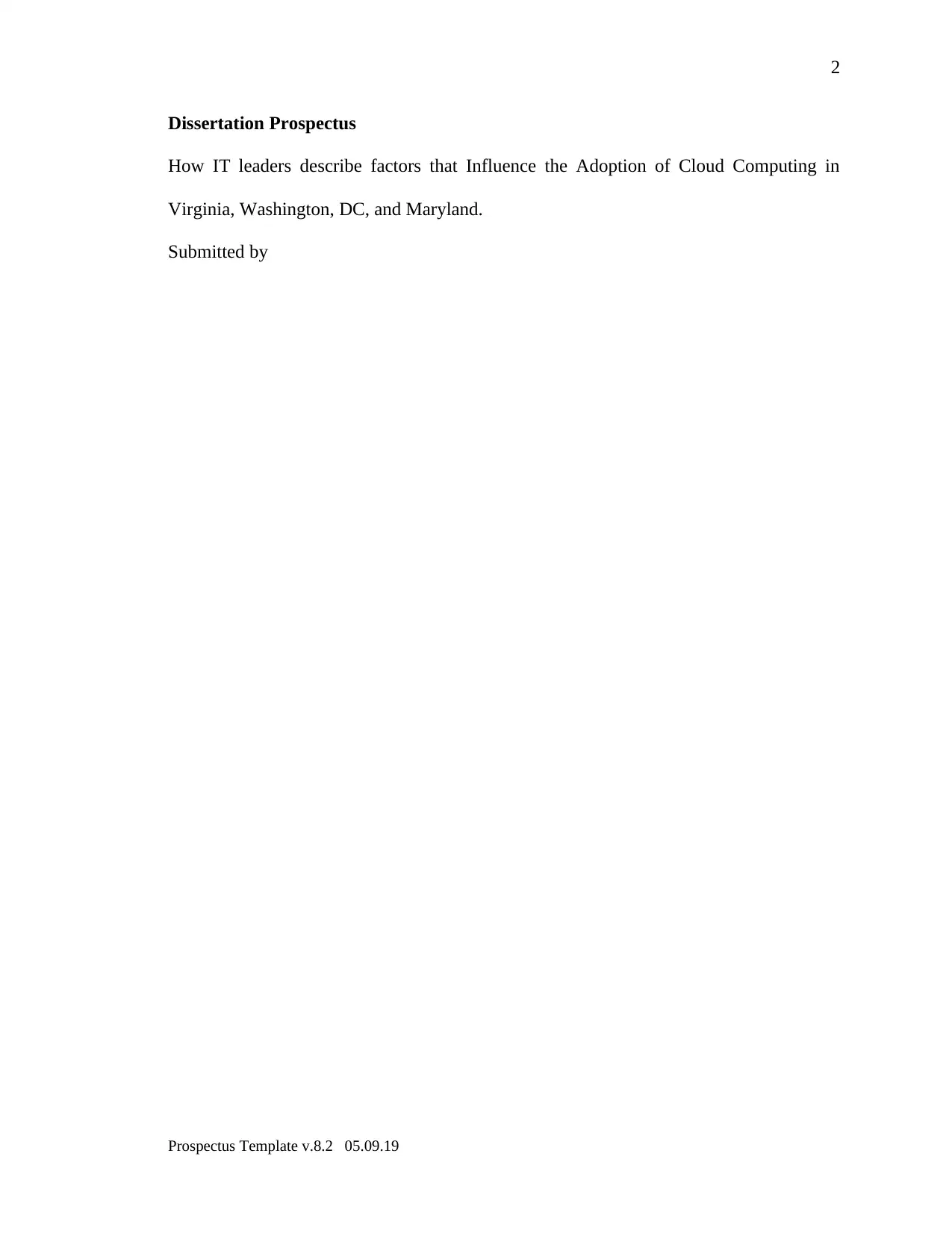
2
Dissertation Prospectus
How IT leaders describe factors that Influence the Adoption of Cloud Computing in
Virginia, Washington, DC, and Maryland.
Submitted by
Prospectus Template v.8.2 05.09.19
Dissertation Prospectus
How IT leaders describe factors that Influence the Adoption of Cloud Computing in
Virginia, Washington, DC, and Maryland.
Submitted by
Prospectus Template v.8.2 05.09.19
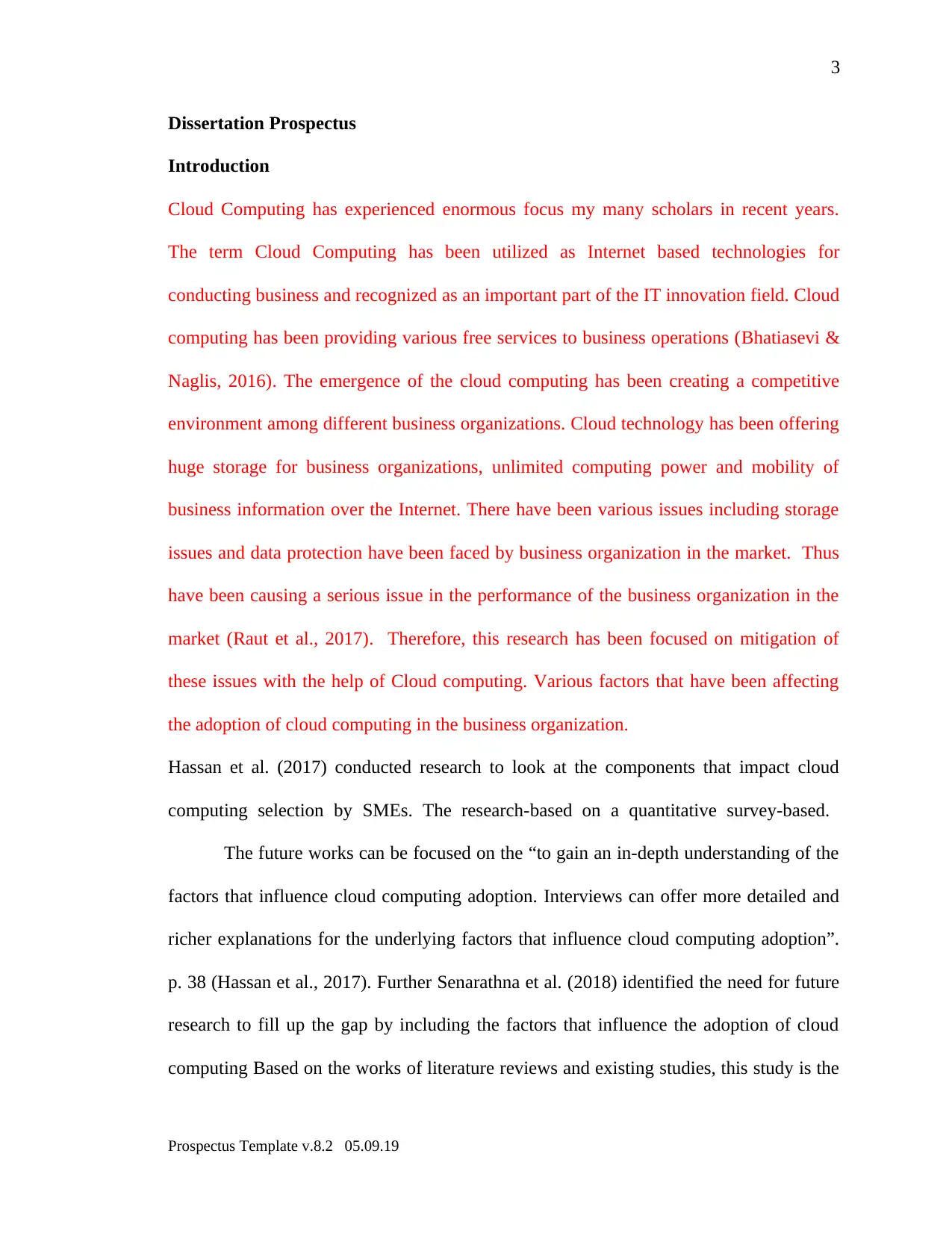
3
Dissertation Prospectus
Introduction
Cloud Computing has experienced enormous focus my many scholars in recent years.
The term Cloud Computing has been utilized as Internet based technologies for
conducting business and recognized as an important part of the IT innovation field. Cloud
computing has been providing various free services to business operations (Bhatiasevi &
Naglis, 2016). The emergence of the cloud computing has been creating a competitive
environment among different business organizations. Cloud technology has been offering
huge storage for business organizations, unlimited computing power and mobility of
business information over the Internet. There have been various issues including storage
issues and data protection have been faced by business organization in the market. Thus
have been causing a serious issue in the performance of the business organization in the
market (Raut et al., 2017). Therefore, this research has been focused on mitigation of
these issues with the help of Cloud computing. Various factors that have been affecting
the adoption of cloud computing in the business organization.
Hassan et al. (2017) conducted research to look at the components that impact cloud
computing selection by SMEs. The research-based on a quantitative survey-based.
The future works can be focused on the “to gain an in-depth understanding of the
factors that influence cloud computing adoption. Interviews can offer more detailed and
richer explanations for the underlying factors that influence cloud computing adoption”.
p. 38 (Hassan et al., 2017). Further Senarathna et al. (2018) identified the need for future
research to fill up the gap by including the factors that influence the adoption of cloud
computing Based on the works of literature reviews and existing studies, this study is the
Prospectus Template v.8.2 05.09.19
Dissertation Prospectus
Introduction
Cloud Computing has experienced enormous focus my many scholars in recent years.
The term Cloud Computing has been utilized as Internet based technologies for
conducting business and recognized as an important part of the IT innovation field. Cloud
computing has been providing various free services to business operations (Bhatiasevi &
Naglis, 2016). The emergence of the cloud computing has been creating a competitive
environment among different business organizations. Cloud technology has been offering
huge storage for business organizations, unlimited computing power and mobility of
business information over the Internet. There have been various issues including storage
issues and data protection have been faced by business organization in the market. Thus
have been causing a serious issue in the performance of the business organization in the
market (Raut et al., 2017). Therefore, this research has been focused on mitigation of
these issues with the help of Cloud computing. Various factors that have been affecting
the adoption of cloud computing in the business organization.
Hassan et al. (2017) conducted research to look at the components that impact cloud
computing selection by SMEs. The research-based on a quantitative survey-based.
The future works can be focused on the “to gain an in-depth understanding of the
factors that influence cloud computing adoption. Interviews can offer more detailed and
richer explanations for the underlying factors that influence cloud computing adoption”.
p. 38 (Hassan et al., 2017). Further Senarathna et al. (2018) identified the need for future
research to fill up the gap by including the factors that influence the adoption of cloud
computing Based on the works of literature reviews and existing studies, this study is the
Prospectus Template v.8.2 05.09.19
⊘ This is a preview!⊘
Do you want full access?
Subscribe today to unlock all pages.

Trusted by 1+ million students worldwide
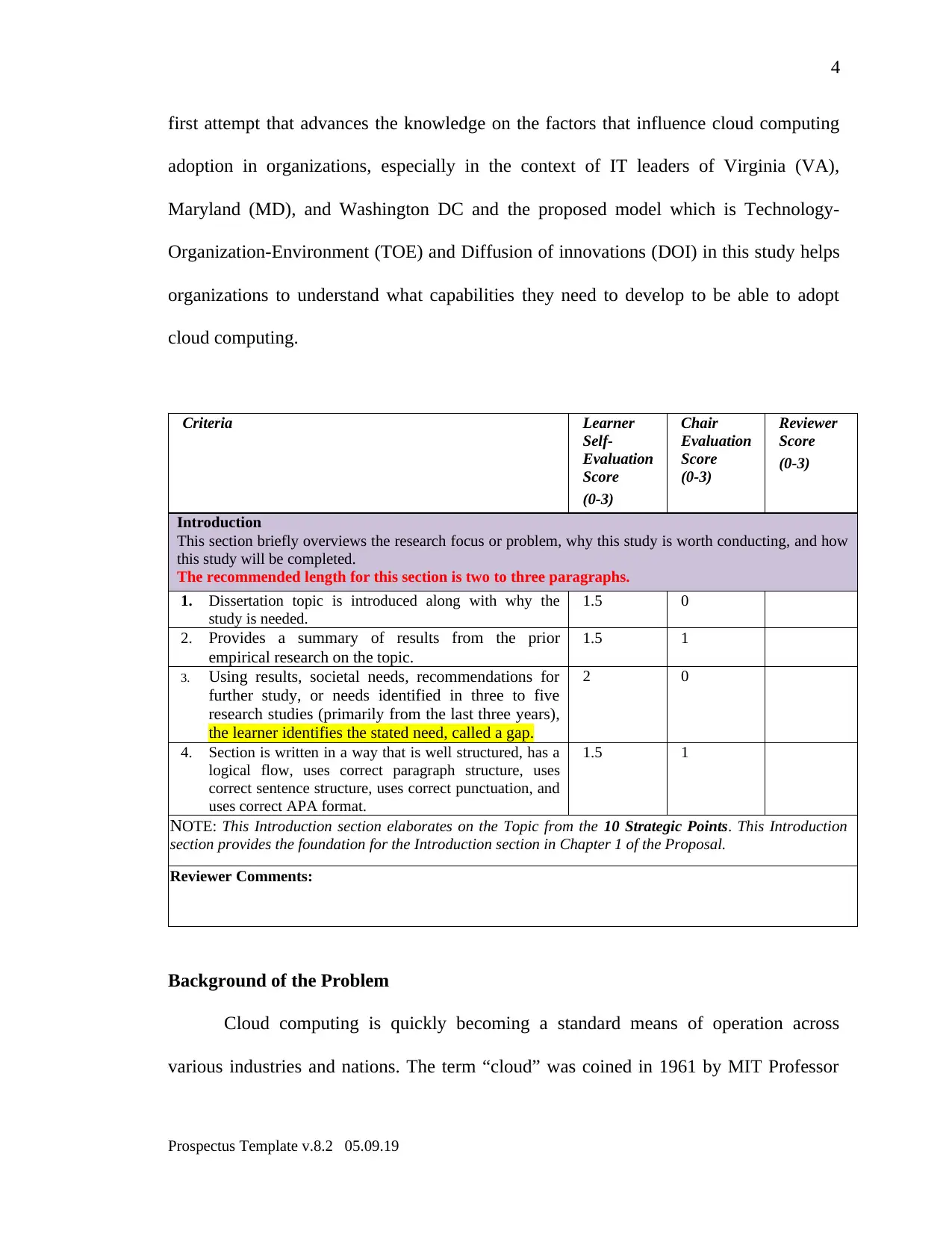
4
first attempt that advances the knowledge on the factors that influence cloud computing
adoption in organizations, especially in the context of IT leaders of Virginia (VA),
Maryland (MD), and Washington DC and the proposed model which is Technology-
Organization-Environment (TOE) and Diffusion of innovations (DOI) in this study helps
organizations to understand what capabilities they need to develop to be able to adopt
cloud computing.
Criteria Learner
Self-
Evaluation
Score
(0-3)
Chair
Evaluation
Score
(0-3)
Reviewer
Score
(0-3)
Introduction
This section briefly overviews the research focus or problem, why this study is worth conducting, and how
this study will be completed.
The recommended length for this section is two to three paragraphs.
1. Dissertation topic is introduced along with why the
study is needed.
1.5 0
2. Provides a summary of results from the prior
empirical research on the topic.
1.5 1
3. Using results, societal needs, recommendations for
further study, or needs identified in three to five
research studies (primarily from the last three years),
the learner identifies the stated need, called a gap.
2 0
4. Section is written in a way that is well structured, has a
logical flow, uses correct paragraph structure, uses
correct sentence structure, uses correct punctuation, and
uses correct APA format.
1.5 1
NOTE: This Introduction section elaborates on the Topic from the 10 Strategic Points. This Introduction
section provides the foundation for the Introduction section in Chapter 1 of the Proposal.
Reviewer Comments:
Background of the Problem
Cloud computing is quickly becoming a standard means of operation across
various industries and nations. The term “cloud” was coined in 1961 by MIT Professor
Prospectus Template v.8.2 05.09.19
first attempt that advances the knowledge on the factors that influence cloud computing
adoption in organizations, especially in the context of IT leaders of Virginia (VA),
Maryland (MD), and Washington DC and the proposed model which is Technology-
Organization-Environment (TOE) and Diffusion of innovations (DOI) in this study helps
organizations to understand what capabilities they need to develop to be able to adopt
cloud computing.
Criteria Learner
Self-
Evaluation
Score
(0-3)
Chair
Evaluation
Score
(0-3)
Reviewer
Score
(0-3)
Introduction
This section briefly overviews the research focus or problem, why this study is worth conducting, and how
this study will be completed.
The recommended length for this section is two to three paragraphs.
1. Dissertation topic is introduced along with why the
study is needed.
1.5 0
2. Provides a summary of results from the prior
empirical research on the topic.
1.5 1
3. Using results, societal needs, recommendations for
further study, or needs identified in three to five
research studies (primarily from the last three years),
the learner identifies the stated need, called a gap.
2 0
4. Section is written in a way that is well structured, has a
logical flow, uses correct paragraph structure, uses
correct sentence structure, uses correct punctuation, and
uses correct APA format.
1.5 1
NOTE: This Introduction section elaborates on the Topic from the 10 Strategic Points. This Introduction
section provides the foundation for the Introduction section in Chapter 1 of the Proposal.
Reviewer Comments:
Background of the Problem
Cloud computing is quickly becoming a standard means of operation across
various industries and nations. The term “cloud” was coined in 1961 by MIT Professor
Prospectus Template v.8.2 05.09.19
Paraphrase This Document
Need a fresh take? Get an instant paraphrase of this document with our AI Paraphraser
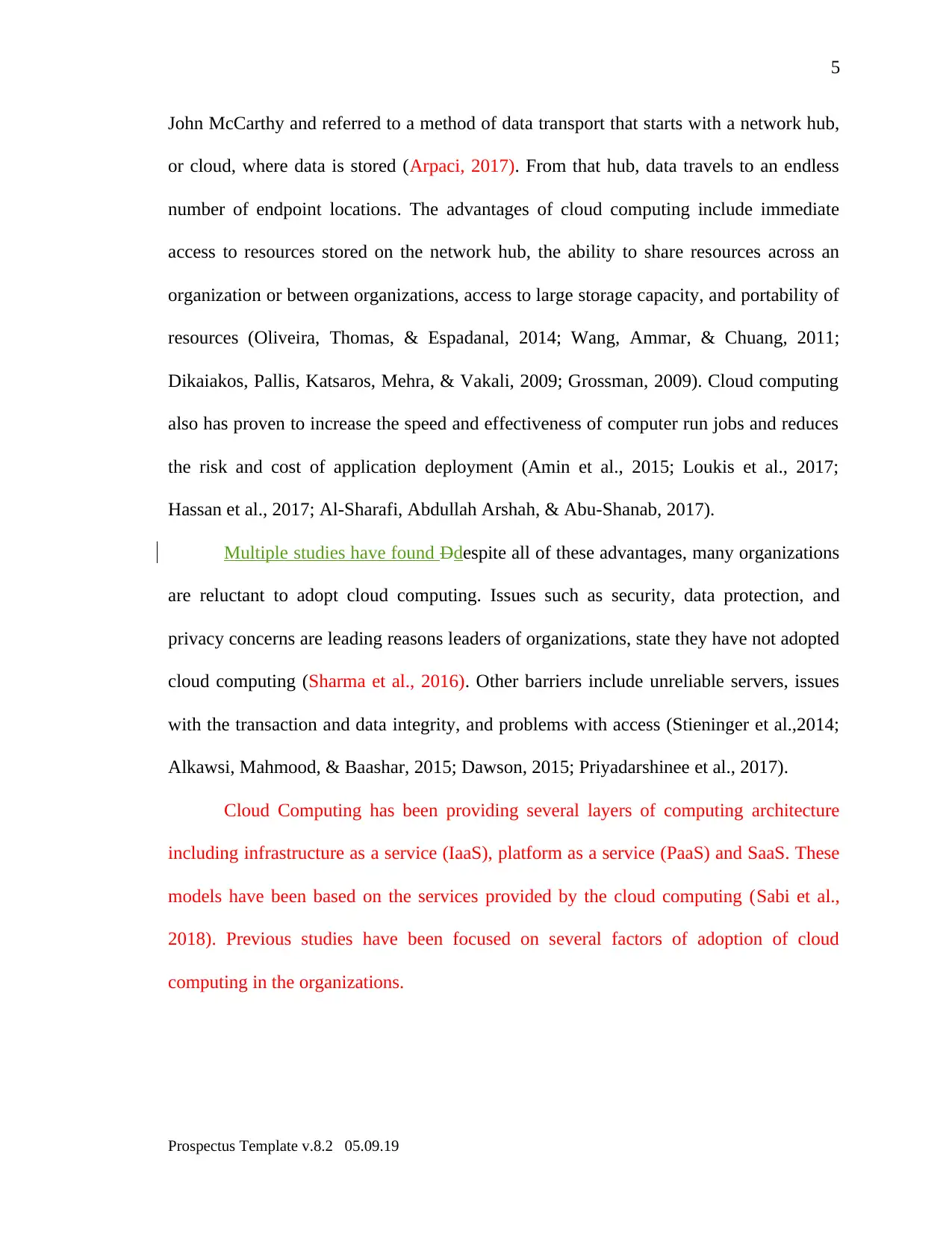
5
John McCarthy and referred to a method of data transport that starts with a network hub,
or cloud, where data is stored (Arpaci, 2017). From that hub, data travels to an endless
number of endpoint locations. The advantages of cloud computing include immediate
access to resources stored on the network hub, the ability to share resources across an
organization or between organizations, access to large storage capacity, and portability of
resources (Oliveira, Thomas, & Espadanal, 2014; Wang, Ammar, & Chuang, 2011;
Dikaiakos, Pallis, Katsaros, Mehra, & Vakali, 2009; Grossman, 2009). Cloud computing
also has proven to increase the speed and effectiveness of computer run jobs and reduces
the risk and cost of application deployment (Amin et al., 2015; Loukis et al., 2017;
Hassan et al., 2017; Al-Sharafi, Abdullah Arshah, & Abu-Shanab, 2017).
Multiple studies have found Ddespite all of these advantages, many organizations
are reluctant to adopt cloud computing. Issues such as security, data protection, and
privacy concerns are leading reasons leaders of organizations, state they have not adopted
cloud computing (Sharma et al., 2016). Other barriers include unreliable servers, issues
with the transaction and data integrity, and problems with access (Stieninger et al.,2014;
Alkawsi, Mahmood, & Baashar, 2015; Dawson, 2015; Priyadarshinee et al., 2017).
Cloud Computing has been providing several layers of computing architecture
including infrastructure as a service (IaaS), platform as a service (PaaS) and SaaS. These
models have been based on the services provided by the cloud computing (Sabi et al.,
2018). Previous studies have been focused on several factors of adoption of cloud
computing in the organizations.
Prospectus Template v.8.2 05.09.19
John McCarthy and referred to a method of data transport that starts with a network hub,
or cloud, where data is stored (Arpaci, 2017). From that hub, data travels to an endless
number of endpoint locations. The advantages of cloud computing include immediate
access to resources stored on the network hub, the ability to share resources across an
organization or between organizations, access to large storage capacity, and portability of
resources (Oliveira, Thomas, & Espadanal, 2014; Wang, Ammar, & Chuang, 2011;
Dikaiakos, Pallis, Katsaros, Mehra, & Vakali, 2009; Grossman, 2009). Cloud computing
also has proven to increase the speed and effectiveness of computer run jobs and reduces
the risk and cost of application deployment (Amin et al., 2015; Loukis et al., 2017;
Hassan et al., 2017; Al-Sharafi, Abdullah Arshah, & Abu-Shanab, 2017).
Multiple studies have found Ddespite all of these advantages, many organizations
are reluctant to adopt cloud computing. Issues such as security, data protection, and
privacy concerns are leading reasons leaders of organizations, state they have not adopted
cloud computing (Sharma et al., 2016). Other barriers include unreliable servers, issues
with the transaction and data integrity, and problems with access (Stieninger et al.,2014;
Alkawsi, Mahmood, & Baashar, 2015; Dawson, 2015; Priyadarshinee et al., 2017).
Cloud Computing has been providing several layers of computing architecture
including infrastructure as a service (IaaS), platform as a service (PaaS) and SaaS. These
models have been based on the services provided by the cloud computing (Sabi et al.,
2018). Previous studies have been focused on several factors of adoption of cloud
computing in the organizations.
Prospectus Template v.8.2 05.09.19
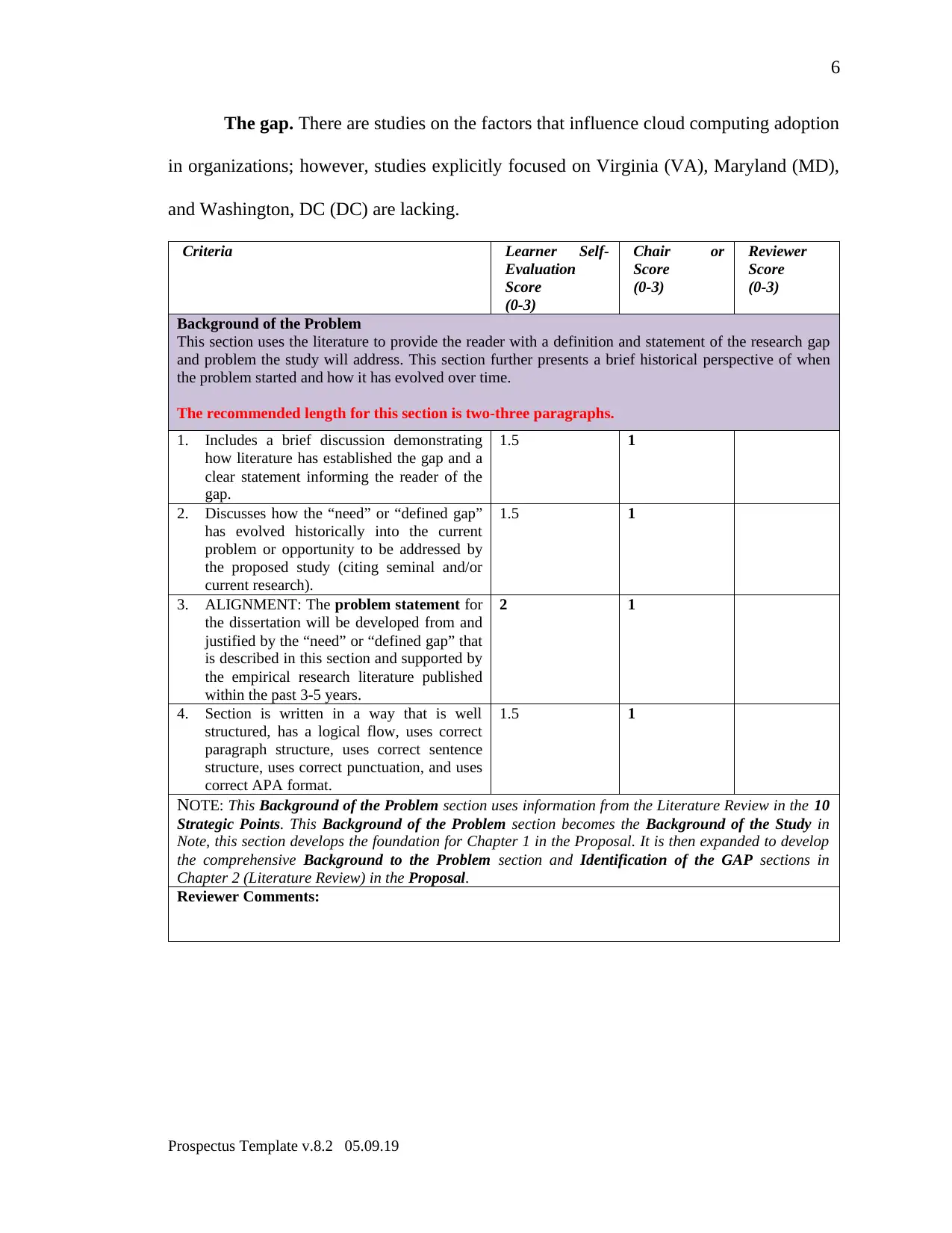
6
The gap. There are studies on the factors that influence cloud computing adoption
in organizations; however, studies explicitly focused on Virginia (VA), Maryland (MD),
and Washington, DC (DC) are lacking.
Criteria Learner Self-
Evaluation
Score
(0-3)
Chair or
Score
(0-3)
Reviewer
Score
(0-3)
Background of the Problem
This section uses the literature to provide the reader with a definition and statement of the research gap
and problem the study will address. This section further presents a brief historical perspective of when
the problem started and how it has evolved over time.
The recommended length for this section is two-three paragraphs.
1. Includes a brief discussion demonstrating
how literature has established the gap and a
clear statement informing the reader of the
gap.
1.5 1
2. Discusses how the “need” or “defined gap”
has evolved historically into the current
problem or opportunity to be addressed by
the proposed study (citing seminal and/or
current research).
1.5 1
3. ALIGNMENT: The problem statement for
the dissertation will be developed from and
justified by the “need” or “defined gap” that
is described in this section and supported by
the empirical research literature published
within the past 3-5 years.
2 1
4. Section is written in a way that is well
structured, has a logical flow, uses correct
paragraph structure, uses correct sentence
structure, uses correct punctuation, and uses
correct APA format.
1.5 1
NOTE: This Background of the Problem section uses information from the Literature Review in the 10
Strategic Points. This Background of the Problem section becomes the Background of the Study in
Note, this section develops the foundation for Chapter 1 in the Proposal. It is then expanded to develop
the comprehensive Background to the Problem section and Identification of the GAP sections in
Chapter 2 (Literature Review) in the Proposal.
Reviewer Comments:
Prospectus Template v.8.2 05.09.19
The gap. There are studies on the factors that influence cloud computing adoption
in organizations; however, studies explicitly focused on Virginia (VA), Maryland (MD),
and Washington, DC (DC) are lacking.
Criteria Learner Self-
Evaluation
Score
(0-3)
Chair or
Score
(0-3)
Reviewer
Score
(0-3)
Background of the Problem
This section uses the literature to provide the reader with a definition and statement of the research gap
and problem the study will address. This section further presents a brief historical perspective of when
the problem started and how it has evolved over time.
The recommended length for this section is two-three paragraphs.
1. Includes a brief discussion demonstrating
how literature has established the gap and a
clear statement informing the reader of the
gap.
1.5 1
2. Discusses how the “need” or “defined gap”
has evolved historically into the current
problem or opportunity to be addressed by
the proposed study (citing seminal and/or
current research).
1.5 1
3. ALIGNMENT: The problem statement for
the dissertation will be developed from and
justified by the “need” or “defined gap” that
is described in this section and supported by
the empirical research literature published
within the past 3-5 years.
2 1
4. Section is written in a way that is well
structured, has a logical flow, uses correct
paragraph structure, uses correct sentence
structure, uses correct punctuation, and uses
correct APA format.
1.5 1
NOTE: This Background of the Problem section uses information from the Literature Review in the 10
Strategic Points. This Background of the Problem section becomes the Background of the Study in
Note, this section develops the foundation for Chapter 1 in the Proposal. It is then expanded to develop
the comprehensive Background to the Problem section and Identification of the GAP sections in
Chapter 2 (Literature Review) in the Proposal.
Reviewer Comments:
Prospectus Template v.8.2 05.09.19
⊘ This is a preview!⊘
Do you want full access?
Subscribe today to unlock all pages.

Trusted by 1+ million students worldwide
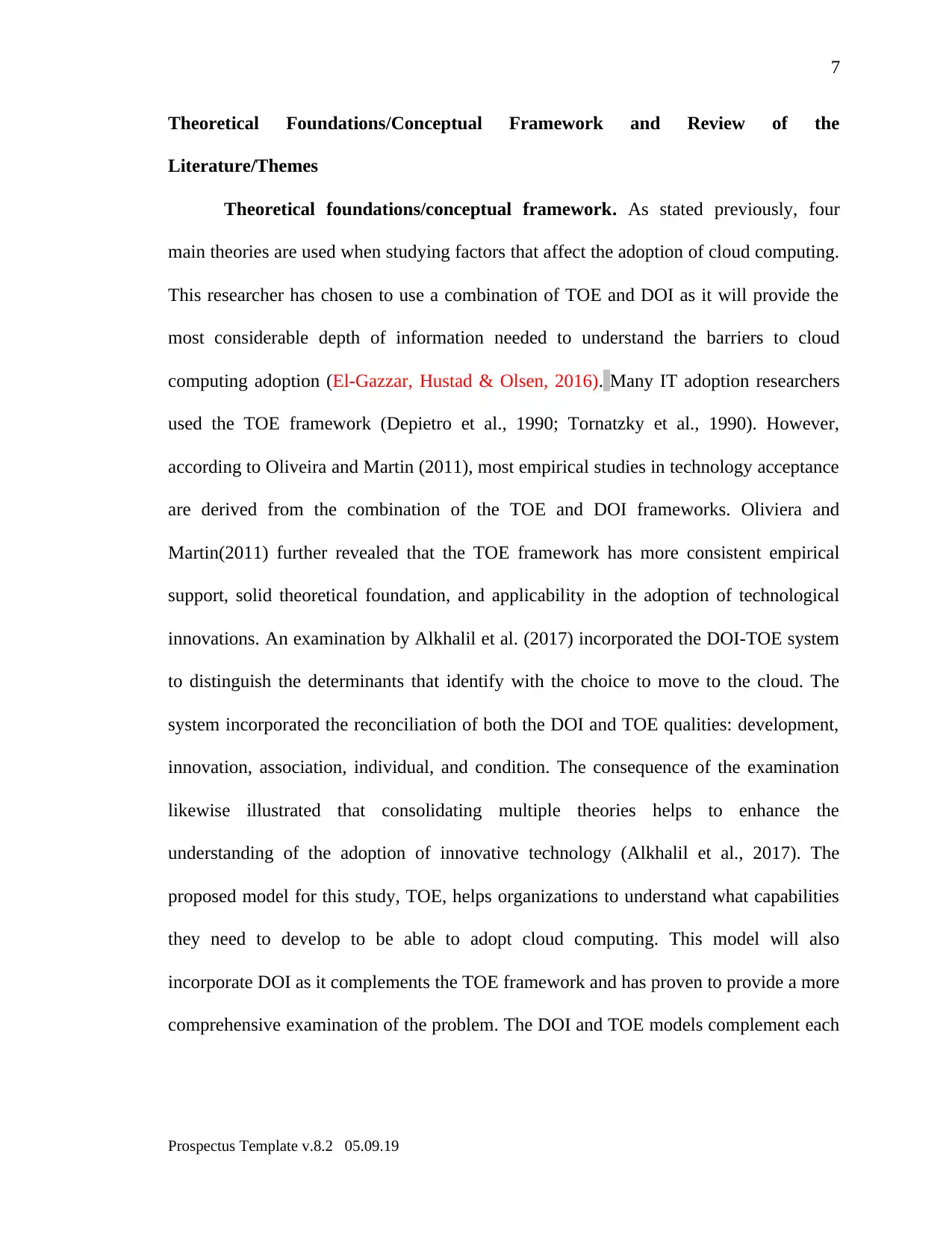
7
Theoretical Foundations/Conceptual Framework and Review of the
Literature/Themes
Theoretical foundations/conceptual framework. As stated previously, four
main theories are used when studying factors that affect the adoption of cloud computing.
This researcher has chosen to use a combination of TOE and DOI as it will provide the
most considerable depth of information needed to understand the barriers to cloud
computing adoption (El-Gazzar, Hustad & Olsen, 2016). Many IT adoption researchers
used the TOE framework (Depietro et al., 1990; Tornatzky et al., 1990). However,
according to Oliveira and Martin (2011), most empirical studies in technology acceptance
are derived from the combination of the TOE and DOI frameworks. Oliviera and
Martin(2011) further revealed that the TOE framework has more consistent empirical
support, solid theoretical foundation, and applicability in the adoption of technological
innovations. An examination by Alkhalil et al. (2017) incorporated the DOI-TOE system
to distinguish the determinants that identify with the choice to move to the cloud. The
system incorporated the reconciliation of both the DOI and TOE qualities: development,
innovation, association, individual, and condition. The consequence of the examination
likewise illustrated that consolidating multiple theories helps to enhance the
understanding of the adoption of innovative technology (Alkhalil et al., 2017). The
proposed model for this study, TOE, helps organizations to understand what capabilities
they need to develop to be able to adopt cloud computing. This model will also
incorporate DOI as it complements the TOE framework and has proven to provide a more
comprehensive examination of the problem. The DOI and TOE models complement each
Prospectus Template v.8.2 05.09.19
Theoretical Foundations/Conceptual Framework and Review of the
Literature/Themes
Theoretical foundations/conceptual framework. As stated previously, four
main theories are used when studying factors that affect the adoption of cloud computing.
This researcher has chosen to use a combination of TOE and DOI as it will provide the
most considerable depth of information needed to understand the barriers to cloud
computing adoption (El-Gazzar, Hustad & Olsen, 2016). Many IT adoption researchers
used the TOE framework (Depietro et al., 1990; Tornatzky et al., 1990). However,
according to Oliveira and Martin (2011), most empirical studies in technology acceptance
are derived from the combination of the TOE and DOI frameworks. Oliviera and
Martin(2011) further revealed that the TOE framework has more consistent empirical
support, solid theoretical foundation, and applicability in the adoption of technological
innovations. An examination by Alkhalil et al. (2017) incorporated the DOI-TOE system
to distinguish the determinants that identify with the choice to move to the cloud. The
system incorporated the reconciliation of both the DOI and TOE qualities: development,
innovation, association, individual, and condition. The consequence of the examination
likewise illustrated that consolidating multiple theories helps to enhance the
understanding of the adoption of innovative technology (Alkhalil et al., 2017). The
proposed model for this study, TOE, helps organizations to understand what capabilities
they need to develop to be able to adopt cloud computing. This model will also
incorporate DOI as it complements the TOE framework and has proven to provide a more
comprehensive examination of the problem. The DOI and TOE models complement each
Prospectus Template v.8.2 05.09.19
Paraphrase This Document
Need a fresh take? Get an instant paraphrase of this document with our AI Paraphraser
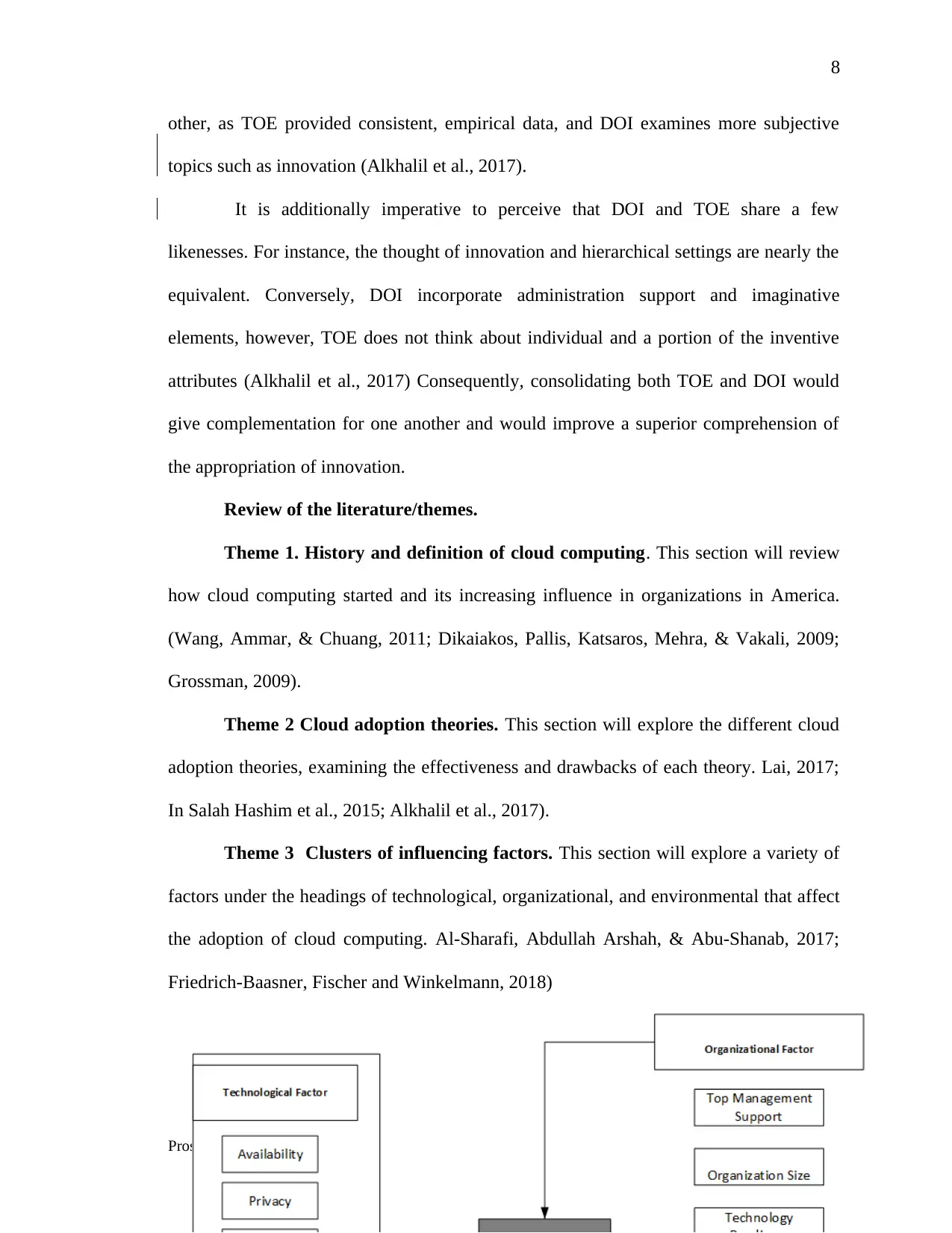
8
other, as TOE provided consistent, empirical data, and DOI examines more subjective
topics such as innovation (Alkhalil et al., 2017).
It is additionally imperative to perceive that DOI and TOE share a few
likenesses. For instance, the thought of innovation and hierarchical settings are nearly the
equivalent. Conversely, DOI incorporate administration support and imaginative
elements, however, TOE does not think about individual and a portion of the inventive
attributes (Alkhalil et al., 2017) Consequently, consolidating both TOE and DOI would
give complementation for one another and would improve a superior comprehension of
the appropriation of innovation.
Review of the literature/themes.
Theme 1. History and definition of cloud computing. This section will review
how cloud computing started and its increasing influence in organizations in America.
(Wang, Ammar, & Chuang, 2011; Dikaiakos, Pallis, Katsaros, Mehra, & Vakali, 2009;
Grossman, 2009).
Theme 2 Cloud adoption theories. This section will explore the different cloud
adoption theories, examining the effectiveness and drawbacks of each theory. Lai, 2017;
In Salah Hashim et al., 2015; Alkhalil et al., 2017).
Theme 3 Clusters of influencing factors. This section will explore a variety of
factors under the headings of technological, organizational, and environmental that affect
the adoption of cloud computing. Al-Sharafi, Abdullah Arshah, & Abu-Shanab, 2017;
Friedrich-Baasner, Fischer and Winkelmann, 2018)
Prospectus Template v.8.2 05.09.19
other, as TOE provided consistent, empirical data, and DOI examines more subjective
topics such as innovation (Alkhalil et al., 2017).
It is additionally imperative to perceive that DOI and TOE share a few
likenesses. For instance, the thought of innovation and hierarchical settings are nearly the
equivalent. Conversely, DOI incorporate administration support and imaginative
elements, however, TOE does not think about individual and a portion of the inventive
attributes (Alkhalil et al., 2017) Consequently, consolidating both TOE and DOI would
give complementation for one another and would improve a superior comprehension of
the appropriation of innovation.
Review of the literature/themes.
Theme 1. History and definition of cloud computing. This section will review
how cloud computing started and its increasing influence in organizations in America.
(Wang, Ammar, & Chuang, 2011; Dikaiakos, Pallis, Katsaros, Mehra, & Vakali, 2009;
Grossman, 2009).
Theme 2 Cloud adoption theories. This section will explore the different cloud
adoption theories, examining the effectiveness and drawbacks of each theory. Lai, 2017;
In Salah Hashim et al., 2015; Alkhalil et al., 2017).
Theme 3 Clusters of influencing factors. This section will explore a variety of
factors under the headings of technological, organizational, and environmental that affect
the adoption of cloud computing. Al-Sharafi, Abdullah Arshah, & Abu-Shanab, 2017;
Friedrich-Baasner, Fischer and Winkelmann, 2018)
Prospectus Template v.8.2 05.09.19
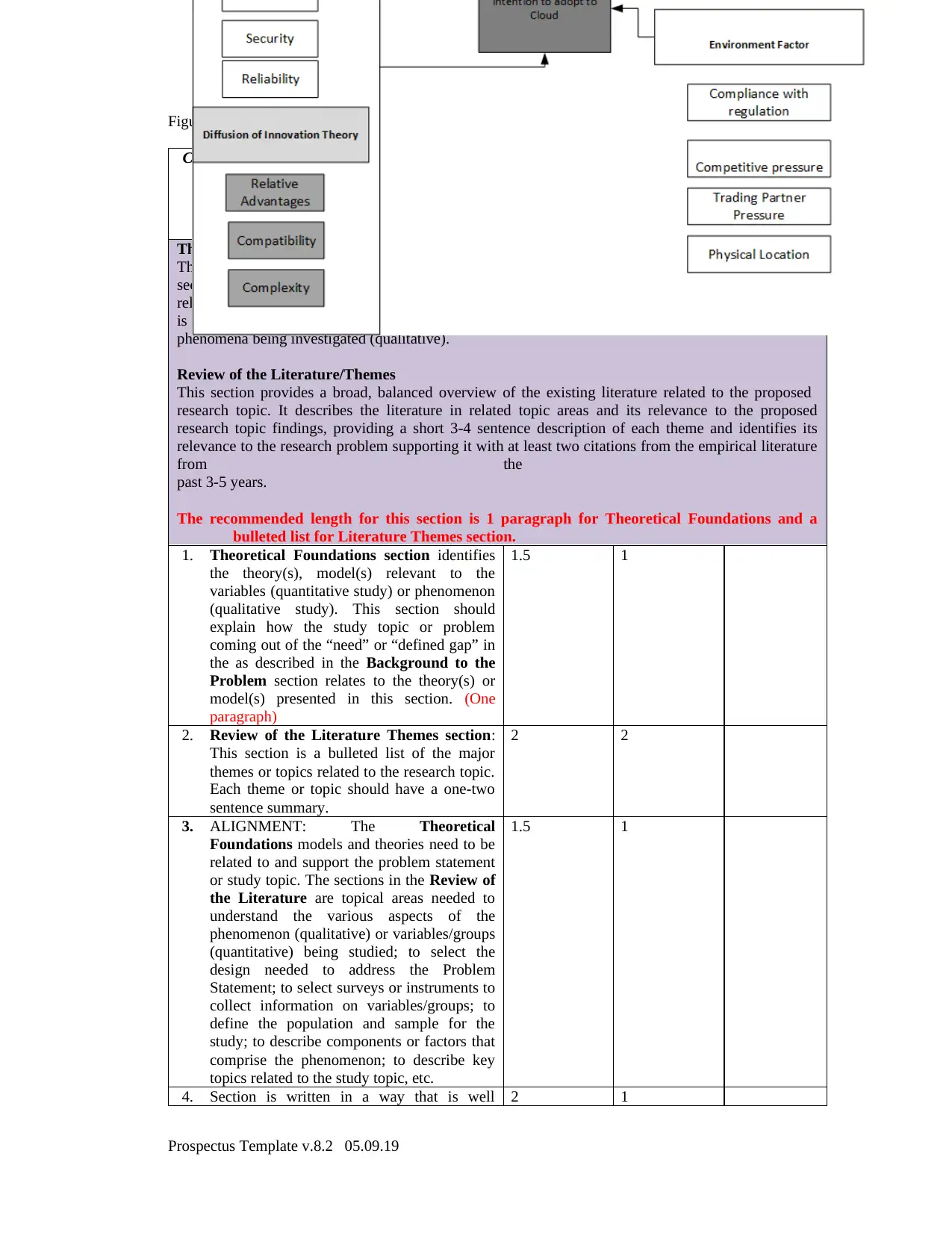
9
Figure 1. The combined TOE+DOI adoption model developed by Alkhater et al. (2014)
Criteria Learner
Self-
Evaluation
Score
(0-3)
Chair or
Score
(0-3)
Reviewer
Score
(0-3)
Theoretical Foundations and/or Conceptual Framework
This section identifies the theory(s) or model(s) that provide the foundation for the research. This
section should present the theory(s) or models(s) and explain how the problem under investigation
relates to the theory or model. The theory(s) or models(s) guide the research questions and justify what
is being measured (variables) as well as how those variables are related (quantitative) or the
phenomena being investigated (qualitative).
Review of the Literature/Themes
This section provides a broad, balanced overview of the existing literature related to the proposed
research topic. It describes the literature in related topic areas and its relevance to the proposed
research topic findings, providing a short 3-4 sentence description of each theme and identifies its
relevance to the research problem supporting it with at least two citations from the empirical literature
from the
past 3-5 years.
The recommended length for this section is 1 paragraph for Theoretical Foundations and a
bulleted list for Literature Themes section.
1. Theoretical Foundations section identifies
the theory(s), model(s) relevant to the
variables (quantitative study) or phenomenon
(qualitative study). This section should
explain how the study topic or problem
coming out of the “need” or “defined gap” in
the as described in the Background to the
Problem section relates to the theory(s) or
model(s) presented in this section. (One
paragraph)
1.5 1
2. Review of the Literature Themes section:
This section is a bulleted list of the major
themes or topics related to the research topic.
Each theme or topic should have a one-two
sentence summary.
2 2
3. ALIGNMENT: The Theoretical
Foundations models and theories need to be
related to and support the problem statement
or study topic. The sections in the Review of
the Literature are topical areas needed to
understand the various aspects of the
phenomenon (qualitative) or variables/groups
(quantitative) being studied; to select the
design needed to address the Problem
Statement; to select surveys or instruments to
collect information on variables/groups; to
define the population and sample for the
study; to describe components or factors that
comprise the phenomenon; to describe key
topics related to the study topic, etc.
1.5 1
4. Section is written in a way that is well 2 1
Prospectus Template v.8.2 05.09.19
Figure 1. The combined TOE+DOI adoption model developed by Alkhater et al. (2014)
Criteria Learner
Self-
Evaluation
Score
(0-3)
Chair or
Score
(0-3)
Reviewer
Score
(0-3)
Theoretical Foundations and/or Conceptual Framework
This section identifies the theory(s) or model(s) that provide the foundation for the research. This
section should present the theory(s) or models(s) and explain how the problem under investigation
relates to the theory or model. The theory(s) or models(s) guide the research questions and justify what
is being measured (variables) as well as how those variables are related (quantitative) or the
phenomena being investigated (qualitative).
Review of the Literature/Themes
This section provides a broad, balanced overview of the existing literature related to the proposed
research topic. It describes the literature in related topic areas and its relevance to the proposed
research topic findings, providing a short 3-4 sentence description of each theme and identifies its
relevance to the research problem supporting it with at least two citations from the empirical literature
from the
past 3-5 years.
The recommended length for this section is 1 paragraph for Theoretical Foundations and a
bulleted list for Literature Themes section.
1. Theoretical Foundations section identifies
the theory(s), model(s) relevant to the
variables (quantitative study) or phenomenon
(qualitative study). This section should
explain how the study topic or problem
coming out of the “need” or “defined gap” in
the as described in the Background to the
Problem section relates to the theory(s) or
model(s) presented in this section. (One
paragraph)
1.5 1
2. Review of the Literature Themes section:
This section is a bulleted list of the major
themes or topics related to the research topic.
Each theme or topic should have a one-two
sentence summary.
2 2
3. ALIGNMENT: The Theoretical
Foundations models and theories need to be
related to and support the problem statement
or study topic. The sections in the Review of
the Literature are topical areas needed to
understand the various aspects of the
phenomenon (qualitative) or variables/groups
(quantitative) being studied; to select the
design needed to address the Problem
Statement; to select surveys or instruments to
collect information on variables/groups; to
define the population and sample for the
study; to describe components or factors that
comprise the phenomenon; to describe key
topics related to the study topic, etc.
1.5 1
4. Section is written in a way that is well 2 1
Prospectus Template v.8.2 05.09.19
⊘ This is a preview!⊘
Do you want full access?
Subscribe today to unlock all pages.

Trusted by 1+ million students worldwide
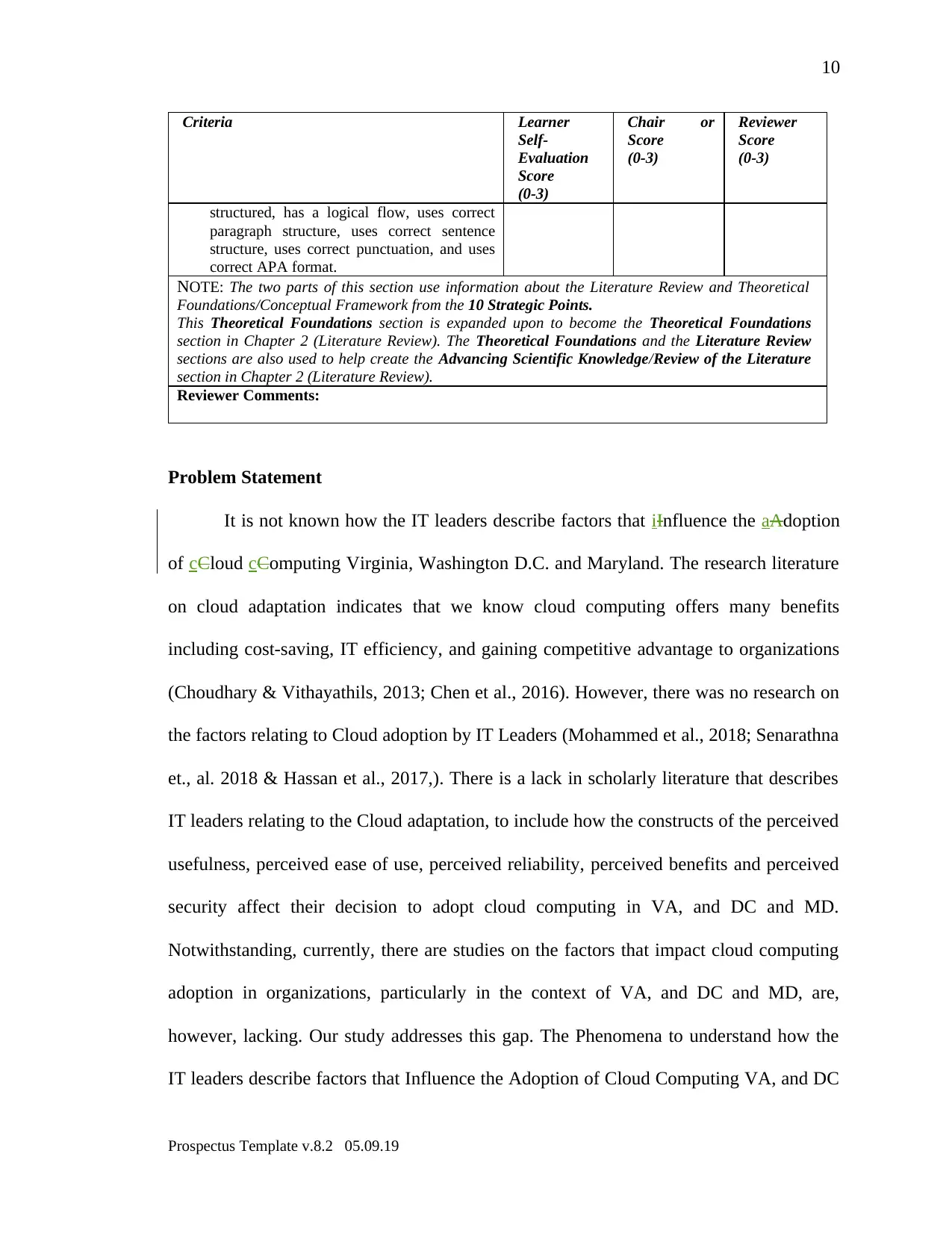
10
Criteria Learner
Self-
Evaluation
Score
(0-3)
Chair or
Score
(0-3)
Reviewer
Score
(0-3)
structured, has a logical flow, uses correct
paragraph structure, uses correct sentence
structure, uses correct punctuation, and uses
correct APA format.
NOTE: The two parts of this section use information about the Literature Review and Theoretical
Foundations/Conceptual Framework from the 10 Strategic Points.
This Theoretical Foundations section is expanded upon to become the Theoretical Foundations
section in Chapter 2 (Literature Review). The Theoretical Foundations and the Literature Review
sections are also used to help create the Advancing Scientific Knowledge/Review of the Literature
section in Chapter 2 (Literature Review).
Reviewer Comments:
Problem Statement
It is not known how the IT leaders describe factors that iInfluence the aAdoption
of cCloud cComputing Virginia, Washington D.C. and Maryland. The research literature
on cloud adaptation indicates that we know cloud computing offers many benefits
including cost-saving, IT efficiency, and gaining competitive advantage to organizations
(Choudhary & Vithayathils, 2013; Chen et al., 2016). However, there was no research on
the factors relating to Cloud adoption by IT Leaders (Mohammed et al., 2018; Senarathna
et., al. 2018 & Hassan et al., 2017,). There is a lack in scholarly literature that describes
IT leaders relating to the Cloud adaptation, to include how the constructs of the perceived
usefulness, perceived ease of use, perceived reliability, perceived benefits and perceived
security affect their decision to adopt cloud computing in VA, and DC and MD.
Notwithstanding, currently, there are studies on the factors that impact cloud computing
adoption in organizations, particularly in the context of VA, and DC and MD, are,
however, lacking. Our study addresses this gap. The Phenomena to understand how the
IT leaders describe factors that Influence the Adoption of Cloud Computing VA, and DC
Prospectus Template v.8.2 05.09.19
Criteria Learner
Self-
Evaluation
Score
(0-3)
Chair or
Score
(0-3)
Reviewer
Score
(0-3)
structured, has a logical flow, uses correct
paragraph structure, uses correct sentence
structure, uses correct punctuation, and uses
correct APA format.
NOTE: The two parts of this section use information about the Literature Review and Theoretical
Foundations/Conceptual Framework from the 10 Strategic Points.
This Theoretical Foundations section is expanded upon to become the Theoretical Foundations
section in Chapter 2 (Literature Review). The Theoretical Foundations and the Literature Review
sections are also used to help create the Advancing Scientific Knowledge/Review of the Literature
section in Chapter 2 (Literature Review).
Reviewer Comments:
Problem Statement
It is not known how the IT leaders describe factors that iInfluence the aAdoption
of cCloud cComputing Virginia, Washington D.C. and Maryland. The research literature
on cloud adaptation indicates that we know cloud computing offers many benefits
including cost-saving, IT efficiency, and gaining competitive advantage to organizations
(Choudhary & Vithayathils, 2013; Chen et al., 2016). However, there was no research on
the factors relating to Cloud adoption by IT Leaders (Mohammed et al., 2018; Senarathna
et., al. 2018 & Hassan et al., 2017,). There is a lack in scholarly literature that describes
IT leaders relating to the Cloud adaptation, to include how the constructs of the perceived
usefulness, perceived ease of use, perceived reliability, perceived benefits and perceived
security affect their decision to adopt cloud computing in VA, and DC and MD.
Notwithstanding, currently, there are studies on the factors that impact cloud computing
adoption in organizations, particularly in the context of VA, and DC and MD, are,
however, lacking. Our study addresses this gap. The Phenomena to understand how the
IT leaders describe factors that Influence the Adoption of Cloud Computing VA, and DC
Prospectus Template v.8.2 05.09.19
Paraphrase This Document
Need a fresh take? Get an instant paraphrase of this document with our AI Paraphraser
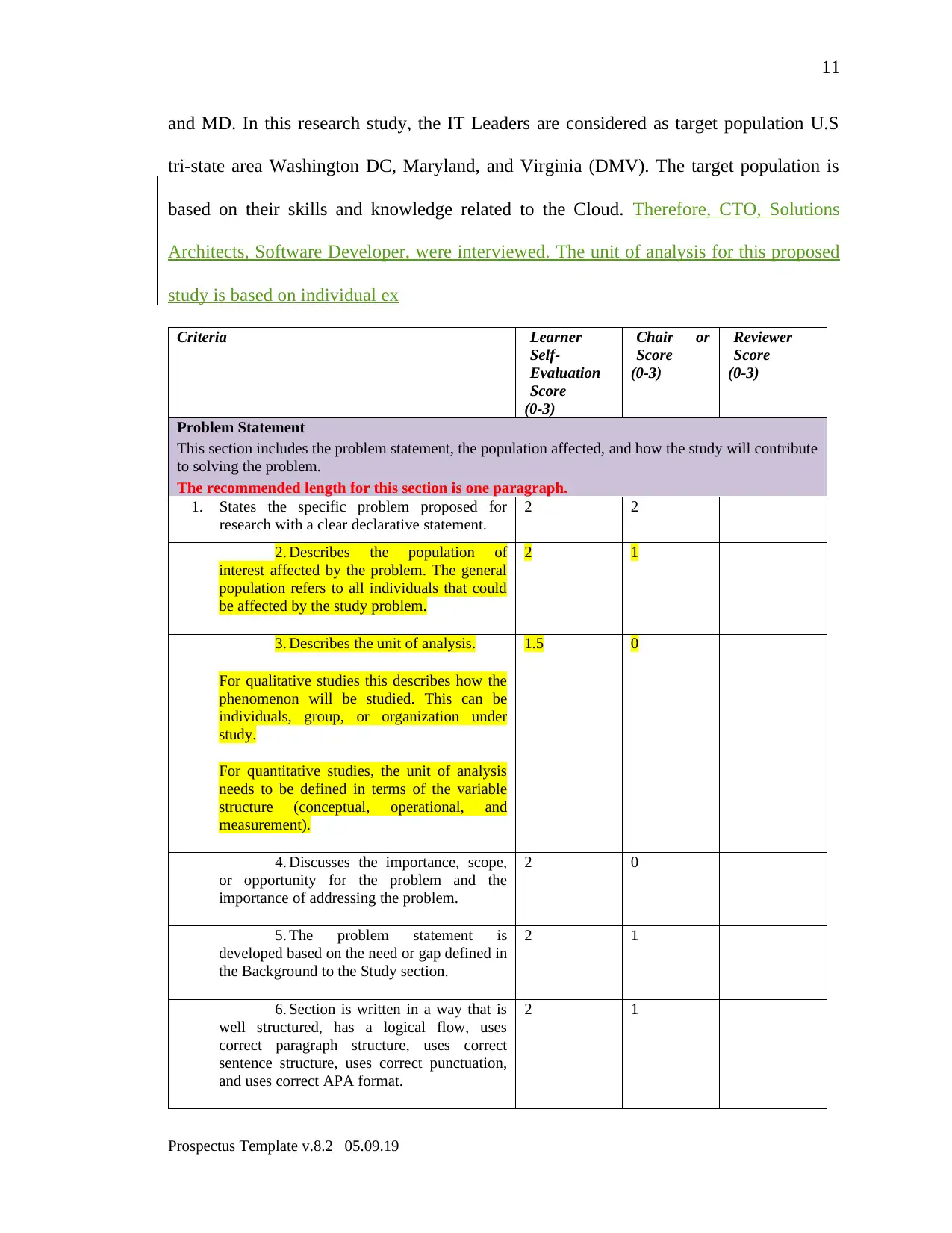
11
and MD. In this research study, the IT Leaders are considered as target population U.S
tri-state area Washington DC, Maryland, and Virginia (DMV). The target population is
based on their skills and knowledge related to the Cloud. Therefore, CTO, Solutions
Architects, Software Developer, were interviewed. The unit of analysis for this proposed
study is based on individual ex
Criteria Learner
Self-
Evaluation
Score
(0-3)
Chair or
Score
(0-3)
Reviewer
Score
(0-3)
Problem Statement
This section includes the problem statement, the population affected, and how the study will contribute
to solving the problem.
The recommended length for this section is one paragraph.
1. States the specific problem proposed for
research with a clear declarative statement.
2 2
2. Describes the population of
interest affected by the problem. The general
population refers to all individuals that could
be affected by the study problem.
2 1
3. Describes the unit of analysis.
For qualitative studies this describes how the
phenomenon will be studied. This can be
individuals, group, or organization under
study.
For quantitative studies, the unit of analysis
needs to be defined in terms of the variable
structure (conceptual, operational, and
measurement).
1.5 0
4. Discusses the importance, scope,
or opportunity for the problem and the
importance of addressing the problem.
2 0
5. The problem statement is
developed based on the need or gap defined in
the Background to the Study section.
2 1
6. Section is written in a way that is
well structured, has a logical flow, uses
correct paragraph structure, uses correct
sentence structure, uses correct punctuation,
and uses correct APA format.
2 1
Prospectus Template v.8.2 05.09.19
and MD. In this research study, the IT Leaders are considered as target population U.S
tri-state area Washington DC, Maryland, and Virginia (DMV). The target population is
based on their skills and knowledge related to the Cloud. Therefore, CTO, Solutions
Architects, Software Developer, were interviewed. The unit of analysis for this proposed
study is based on individual ex
Criteria Learner
Self-
Evaluation
Score
(0-3)
Chair or
Score
(0-3)
Reviewer
Score
(0-3)
Problem Statement
This section includes the problem statement, the population affected, and how the study will contribute
to solving the problem.
The recommended length for this section is one paragraph.
1. States the specific problem proposed for
research with a clear declarative statement.
2 2
2. Describes the population of
interest affected by the problem. The general
population refers to all individuals that could
be affected by the study problem.
2 1
3. Describes the unit of analysis.
For qualitative studies this describes how the
phenomenon will be studied. This can be
individuals, group, or organization under
study.
For quantitative studies, the unit of analysis
needs to be defined in terms of the variable
structure (conceptual, operational, and
measurement).
1.5 0
4. Discusses the importance, scope,
or opportunity for the problem and the
importance of addressing the problem.
2 0
5. The problem statement is
developed based on the need or gap defined in
the Background to the Study section.
2 1
6. Section is written in a way that is
well structured, has a logical flow, uses
correct paragraph structure, uses correct
sentence structure, uses correct punctuation,
and uses correct APA format.
2 1
Prospectus Template v.8.2 05.09.19
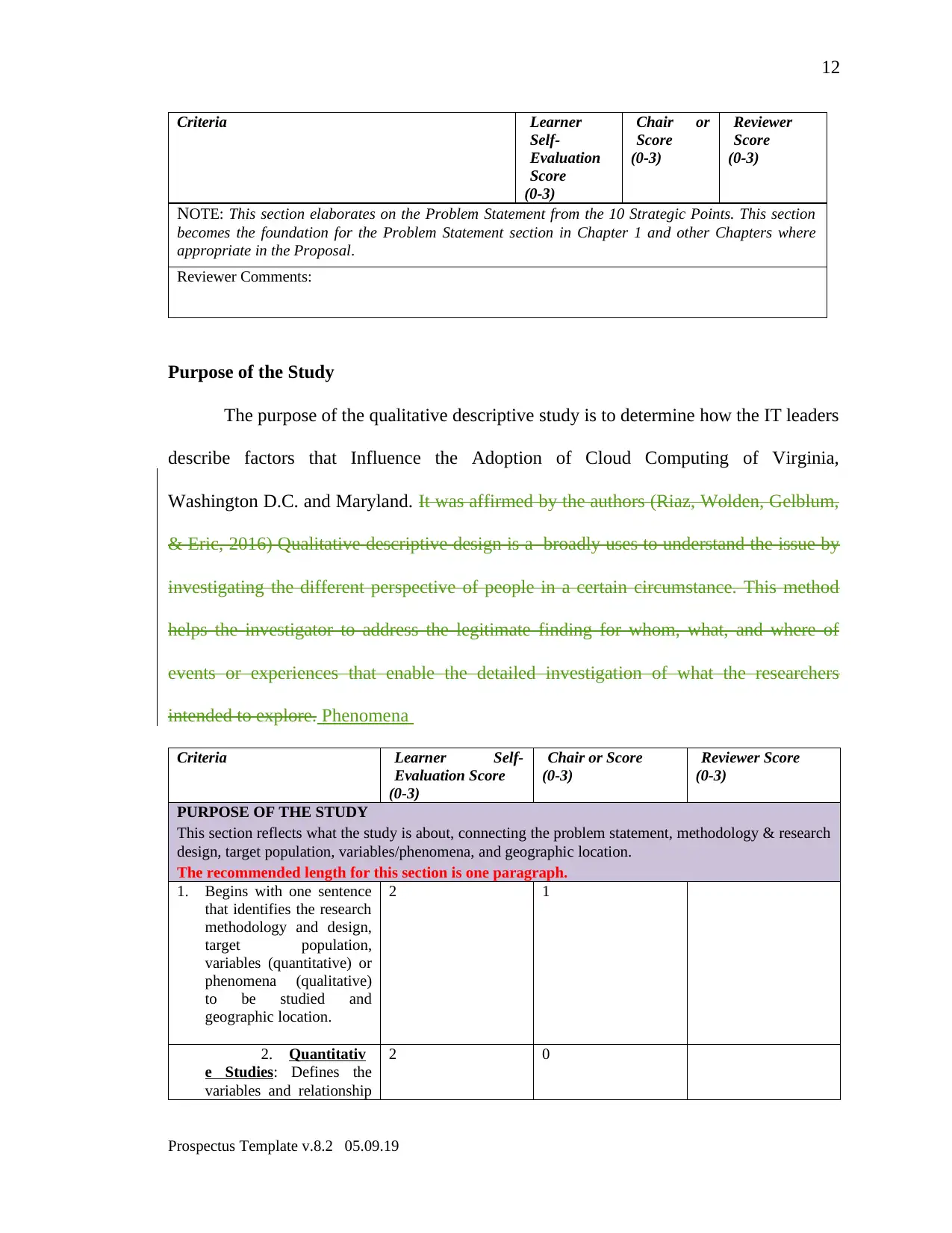
12
Criteria Learner
Self-
Evaluation
Score
(0-3)
Chair or
Score
(0-3)
Reviewer
Score
(0-3)
NOTE: This section elaborates on the Problem Statement from the 10 Strategic Points. This section
becomes the foundation for the Problem Statement section in Chapter 1 and other Chapters where
appropriate in the Proposal.
Reviewer Comments:
Purpose of the Study
The purpose of the qualitative descriptive study is to determine how the IT leaders
describe factors that Influence the Adoption of Cloud Computing of Virginia,
Washington D.C. and Maryland. It was affirmed by the authors (Riaz, Wolden, Gelblum,
& Eric, 2016) Qualitative descriptive design is a broadly uses to understand the issue by
investigating the different perspective of people in a certain circumstance. This method
helps the investigator to address the legitimate finding for whom, what, and where of
events or experiences that enable the detailed investigation of what the researchers
intended to explore. Phenomena
Criteria Learner Self-
Evaluation Score
(0-3)
Chair or Score
(0-3)
Reviewer Score
(0-3)
PURPOSE OF THE STUDY
This section reflects what the study is about, connecting the problem statement, methodology & research
design, target population, variables/phenomena, and geographic location.
The recommended length for this section is one paragraph.
1. Begins with one sentence
that identifies the research
methodology and design,
target population,
variables (quantitative) or
phenomena (qualitative)
to be studied and
geographic location.
2 1
2. Quantitativ
e Studies: Defines the
variables and relationship
2 0
Prospectus Template v.8.2 05.09.19
Criteria Learner
Self-
Evaluation
Score
(0-3)
Chair or
Score
(0-3)
Reviewer
Score
(0-3)
NOTE: This section elaborates on the Problem Statement from the 10 Strategic Points. This section
becomes the foundation for the Problem Statement section in Chapter 1 and other Chapters where
appropriate in the Proposal.
Reviewer Comments:
Purpose of the Study
The purpose of the qualitative descriptive study is to determine how the IT leaders
describe factors that Influence the Adoption of Cloud Computing of Virginia,
Washington D.C. and Maryland. It was affirmed by the authors (Riaz, Wolden, Gelblum,
& Eric, 2016) Qualitative descriptive design is a broadly uses to understand the issue by
investigating the different perspective of people in a certain circumstance. This method
helps the investigator to address the legitimate finding for whom, what, and where of
events or experiences that enable the detailed investigation of what the researchers
intended to explore. Phenomena
Criteria Learner Self-
Evaluation Score
(0-3)
Chair or Score
(0-3)
Reviewer Score
(0-3)
PURPOSE OF THE STUDY
This section reflects what the study is about, connecting the problem statement, methodology & research
design, target population, variables/phenomena, and geographic location.
The recommended length for this section is one paragraph.
1. Begins with one sentence
that identifies the research
methodology and design,
target population,
variables (quantitative) or
phenomena (qualitative)
to be studied and
geographic location.
2 1
2. Quantitativ
e Studies: Defines the
variables and relationship
2 0
Prospectus Template v.8.2 05.09.19
⊘ This is a preview!⊘
Do you want full access?
Subscribe today to unlock all pages.

Trusted by 1+ million students worldwide
1 out of 44
Related Documents
Your All-in-One AI-Powered Toolkit for Academic Success.
+13062052269
info@desklib.com
Available 24*7 on WhatsApp / Email
![[object Object]](/_next/static/media/star-bottom.7253800d.svg)
Unlock your academic potential
Copyright © 2020–2025 A2Z Services. All Rights Reserved. Developed and managed by ZUCOL.




